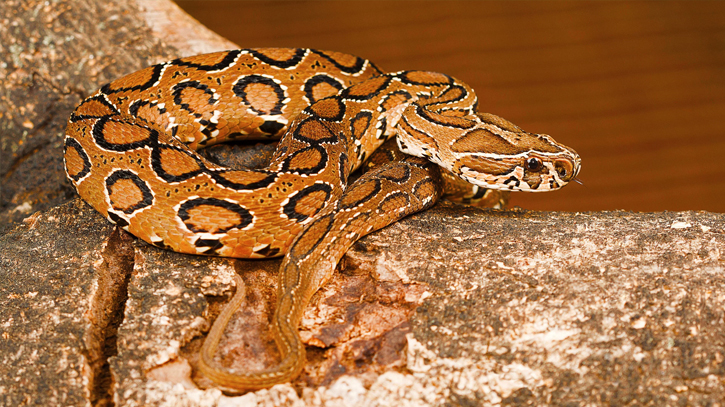
Photo : Collected
Experts urged all not to pay heed to misinformation over Russell's viper, one of the most venomous snakes, as the nearly extinct species of the snake was spotted in some districts in the country.
"Prevalence history of Russell's viper is very old in Bangladesh. Russell's viper (locally known as Chandraboroa) was seen hardly in any districts till 2013," wildlife and snake expert Abu Saeed said on Saturday (29 June).
"In Bangladesh, there are around 119 snake species. Of them, eighty percent of snakes are nonpoisonous," he added.
Narrating prevalence history of Russell's viper, Abu Saeed, who won Bangabandhu Award for Wildlife Conservation-2023, said Russell's viper was found in Rajshahi, Rangpur and Khulna regions in a very limited scale before 2002.
Two Russell's vipers were found and killed in Rajshahi University in 2002 and these are conserved at the Zoology department, the wildlife expert said, adding "The first incident of Russell's viper's bite was reported on March 13, 2013 in Nachol upazila of Chapainawabganj district."
The victim was admitted to the Rajshahi Medical College and two weeks later he died, Abu Saeed.
Although a significant number of people are bitten by different species of snakes and many of them die from snakebite every year in the country, he asserted.
The most venomous species of snakes Karait and Cobra are living across the country and these two species of snake are the most poisonous ones compared to the Russell's viper, Abu Saeed added.
Since 2013, prevalence rate of Russell's viper has increased sharply in Bangladesh due to human-induced intervention, the award winning wildlife expert said.
"Natural predators like mongoose, monitor lizard, forest cat, eagle and crane help control the viper population. The killing of these predators has contributed to an increase in viper numbers," he added.
In several districts, fear of Russell's viper has led to erroneous killing of other snakes, Abu Saeed said and attributed the incident to misinformation on social media.
"There is a lot of misinformation circulating on social media on Russell's viper, which led people killing the python snake.
The expert focused on maintaining ecological balance, urging the people to refrain from killing of wildlife, which survive by eating eggs of snakes.
Abu Saeed said, "Till now, there is no comprehensive study on snakes in the country . . . despite a significant number of people die each year because of snake bites in the country, but this critical issue is still neglected."
He called upon all relevant organizations, ministries and non-government organizations to work together to handle the challenges of sharp rise of Russell's viper.
Dr. Ahmedul Kabir, Additional Director General of the Directorate General of Health Services (DGHS), said there are adequate amounts of anti-venom at all public hospitals to treat the victims bite by Russell's Viper, the highly venomous snake.
"The most important task is to take snakebite victims to a doctor at the quickest possible time . . . timely medical intervention can fully cure snakebite victims through proper treatment," he added.
The DGHS official said, "Anti-venoms are available at all public hospitals including upazila level hospitals and heath complexes at union level. Our doctors and healthcare workers are skilled enough to treat snake bite victims."
According to the DGHS, around 4.03 lakh people are bitten by snakes every year in Bangladesh, and 7,511 of them die of snake bites.
Messenger/Mumu








